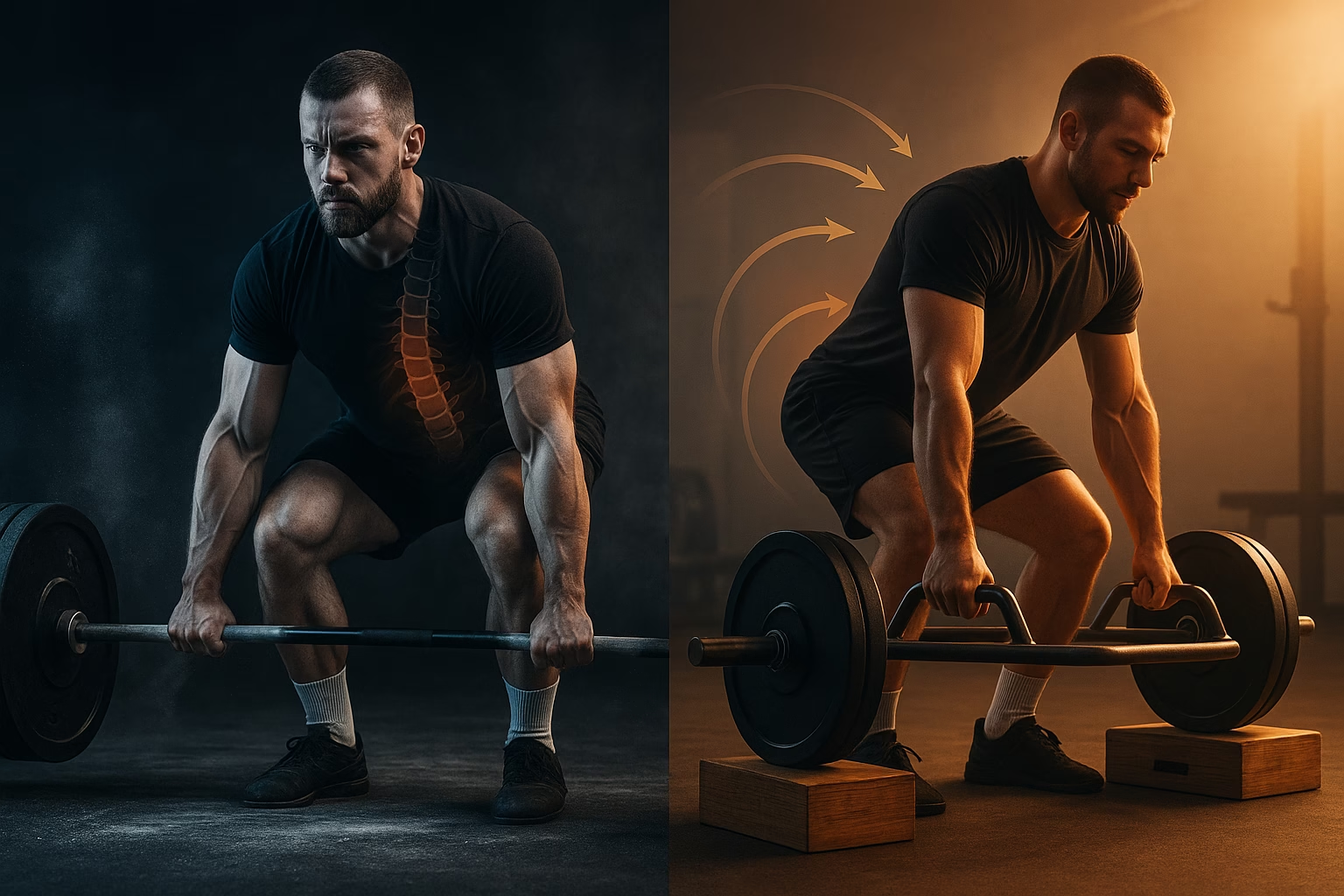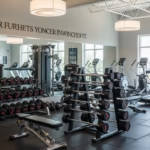Don’t let back pain end your powerlifting journey. Learn how to modify, adapt, and come back stronger.
The Back Pain Game Plan
- Acute pain (0-72 hours): Rest, ice, gentle movement
- Subacute (3 days-6 weeks): Modified training, pain-free ranges
- Chronic (6+ weeks): Progressive loading, movement quality focus
- Never train through sharp, shooting pain
🚨 First Things First: When to Stop vs. When to Modify
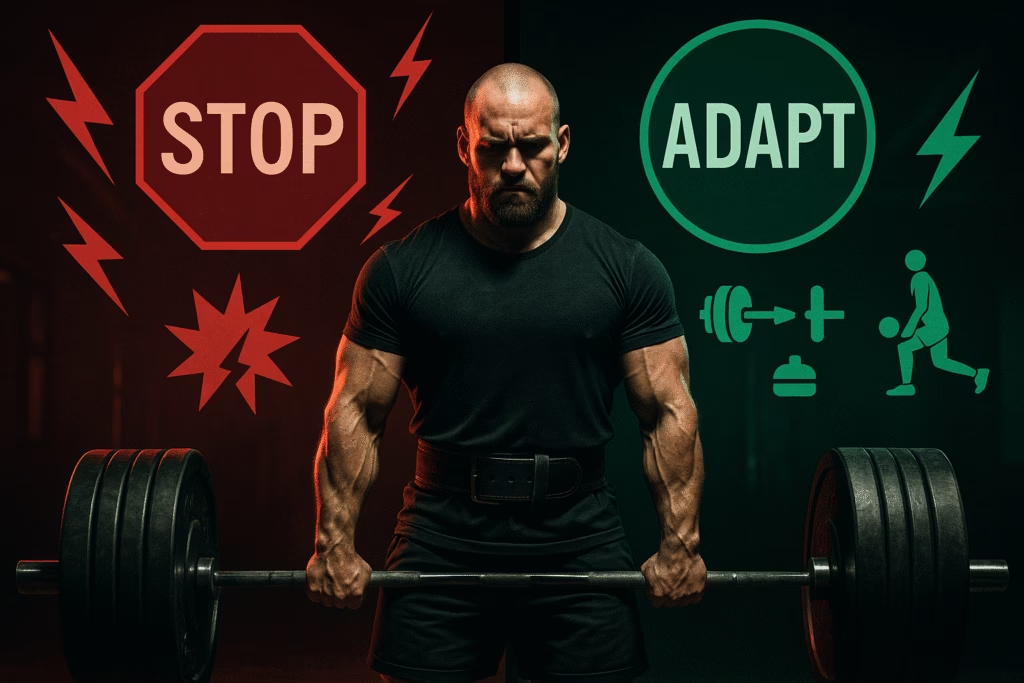
Stop Training Immediately If You Have:
- Sharp, shooting pain down your legs (sciatica)
- Numbness or tingling in legs/feet
- Loss of bowel/bladder control (emergency!)
- Pain that worsens with any movement
- New onset severe pain after a “pop” or “tear”
You Can Likely Train Around:
- Dull, achy lower back stiffness
- Pain that improves with movement and warmth
- Familiar pain patterns you’ve managed before
- Soreness without neurological symptoms
- Pain rated 3-5 out of 10 that doesn’t worsen
Golden rule: When in doubt, get it checked out. A sports medicine doctor who understands powerlifting can give you the green light to train smart.
📊 Understanding Your Back Pain Timeline
Acute Phase (0-72 hours)
What’s happening: Inflammation, muscle guarding, tissue irritation Your goal: Reduce inflammation, maintain gentle movement Training approach: Complete rest from lifting, walking as tolerated
Subacute Phase (3 days to 6 weeks)
What’s happening: Healing begins, movement tolerance improves Your goal: Gradual return to loading without aggravating symptoms Training approach: Modified exercises, reduced ranges of motion
Chronic Phase (6+ weeks)
What’s happening: Tissues have healed, fear and movement patterns may persist Your goal: Progressive loading, confidence building, return to normal training Training approach: Systematic progression back to full training
🔧 Exercise Modifications for Each Powerlifting Movement
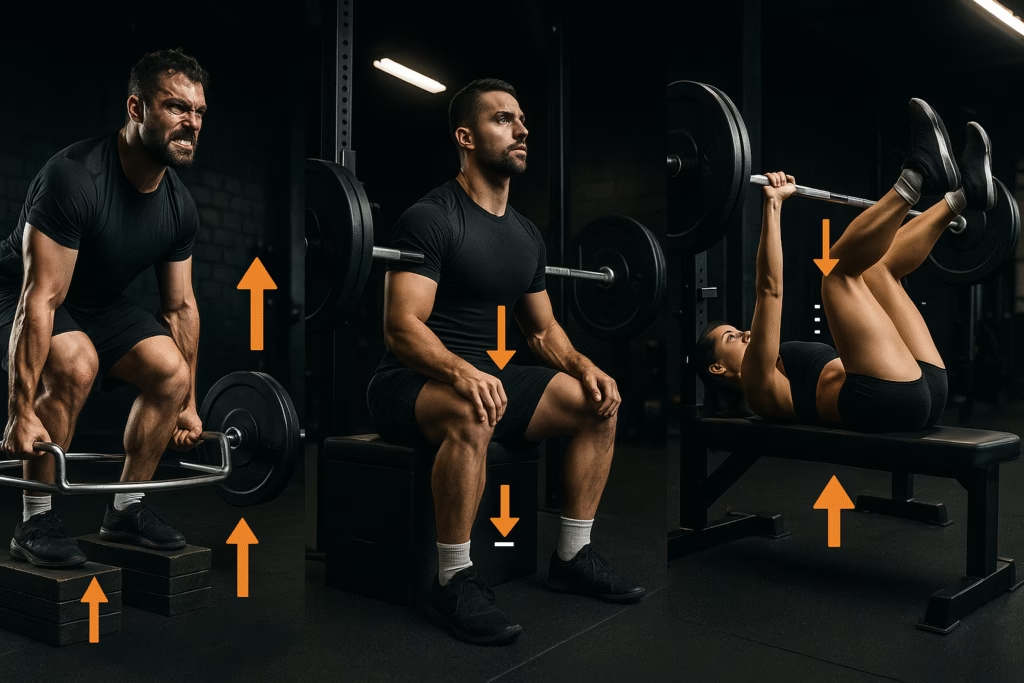
Deadlift Alternatives When Your Back Hurts
Level 1: Acute Pain Management
Trap bar deadlifts from blocks: Reduces spine flexion, higher starting position
- Start with blocks 4-6 inches high
- Focus on hip hinge pattern
- Use 40-60% of normal deadlift weight
Romanian deadlifts (light): Maintains hip hinge pattern without floor pickup
- Keep bar above knee level
- Focus on glute and hamstring engagement
- Use 30-50% of normal deadlift weight
Level 2: Building Back Up
Rack pulls from knee height: Gradual progression toward floor
- Start at knee height, lower 1 inch per week
- Focus on maintaining neutral spine
- Progress weight conservatively
Sumo deadlifts: Often more comfortable for back issues
- Wider stance reduces spine flexion
- More upright torso position
- May allow heavier loading sooner
Level 3: Return to Competition Deadlifts
Deficit deadlifts (reverse): Start from blocks, progress to floor
- Week 1-2: 4-inch deficit reduction
- Week 3-4: 2-inch deficit reduction
- Week 5-6: Floor level
- Week 7+: Consider small deficits
Squat Modifications for Back Pain
Level 1: Acute Phase Alternatives
Goblet squats: Reduces spinal loading, promotes good posture
- Hold dumbbell or kettlebell at chest
- Focus on movement quality over weight
- Usually pain-free range of motion
Box squats to high box: Controls depth, reduces eccentric loading
- Set box 2-4 inches above normal depth
- Sit back fully, pause, stand up
- Gradually lower box height weekly
Level 2: Progressive Loading
Front squats: Promotes upright posture, less back stress
- Easier to maintain neutral spine
- Lower weights but great training effect
- Build up slowly – front squats are humbling
Safety bar squats: Cambered bar reduces shoulder stress
- More comfortable bar position
- Allows focus on leg strength
- Often pain-free when back squats aren’t
Level 3: Return to Back Squats
Pin squats: Eliminate eccentric (lowering) portion
- Set pins at comfortable depth
- Start each rep from dead stop
- Progress depth and weight gradually
Anderson squats: Build strength in sticking points
- Start from pins in bottom position
- Eliminates stretch reflex
- Builds confidence in bottom position
Bench Press Considerations
Why Bench Press Can Aggravate Back Pain:
- Excessive arching to improve leverage
- Tight hip flexors pulling on lumbar spine
- Poor setup creating compensatory patterns
Back-Friendly Bench Modifications:
Feet-up bench press: Eliminates excessive arch
- Keeps lower back neutral
- May need to reduce weight 10-15%
- Still allows heavy pressing work
Incline bench press: More upright position
- Less stress on lower back
- Targets upper chest differently
- Often completely pain-free
Floor press: Limits range of motion
- Reduces shoulder and back stress
- Builds lockout strength
- Can often handle full weights
💪 Accessory Exercises That Help (And Hurt)
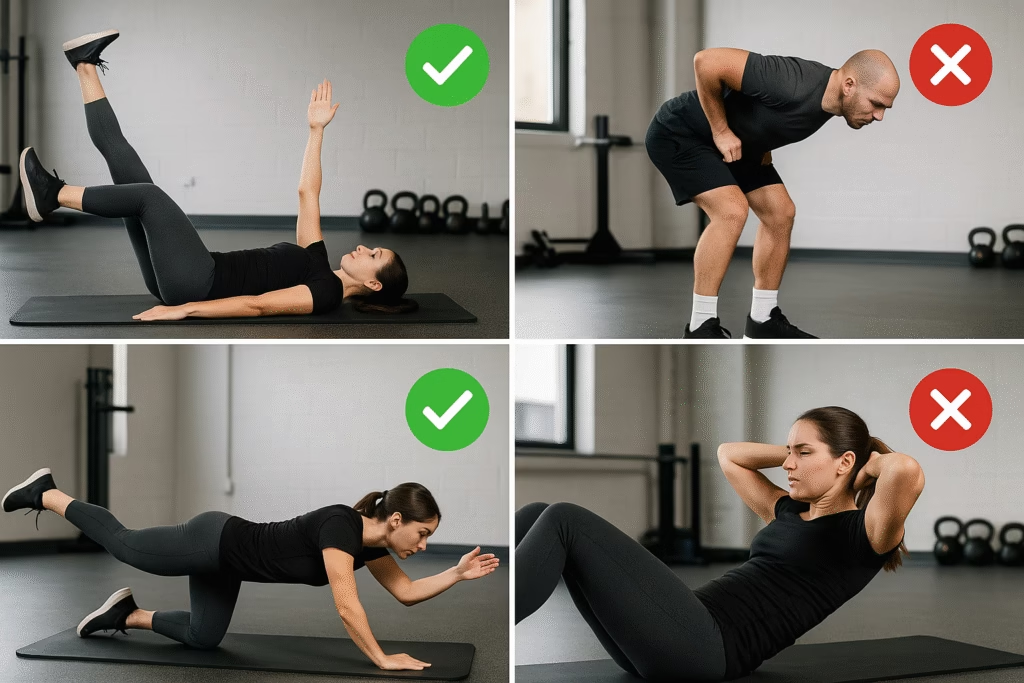
Exercises That Usually Help Back Pain
Core Stability (Not Crunches!)
Dead bugs: Teaches core stability without spine flexion
- Lie on back, opposite arm/leg extensions
- Hold 5-10 seconds each rep
- 2-3 sets of 8-12 per side
Bird dogs: Builds posterior chain endurance
- Start on hands and knees
- Extend opposite arm and leg
- Hold 10-15 seconds, 10 reps each side
Plank variations: Builds anti-extension strength
- Standard, side, and reverse planks
- Progress time before adding weight
- 3 sets of 30-60 seconds
Hip Mobility and Strength
Hip flexor stretches: Reduces pull on lumbar spine
- Couch stretch, 90/90 stretch
- Hold 2-3 minutes each position
- Perform 2-3 times daily
Glute bridges: Strengthens often-weak glutes
- Squeeze glutes at top for 2 seconds
- Progress to single-leg variations
- 3 sets of 15-20 reps
Clamshells: Targets glute medius
- Side-lying with band around knees
- Focus on quality over quantity
- 2 sets of 15-20 each side
Exercises to Avoid During Back Pain
Movements That Often Aggravate:
- Good mornings: Too much spine flexion under load
- Sit-ups/crunches: Repeated spine flexion
- Leg press: Can force spine into flexion
- Overhead pressing: May increase back arch compensation
- Heavy rows: Can stress lower back in bent position
Why These Movements Hurt:
Back pain often involves inflammation and muscle guarding. Movements that put your spine into flexion (rounding forward) or extreme extension (arching back) can irritate already sensitive tissues.
📈 Progressive Loading: Your 6-Week Return Plan
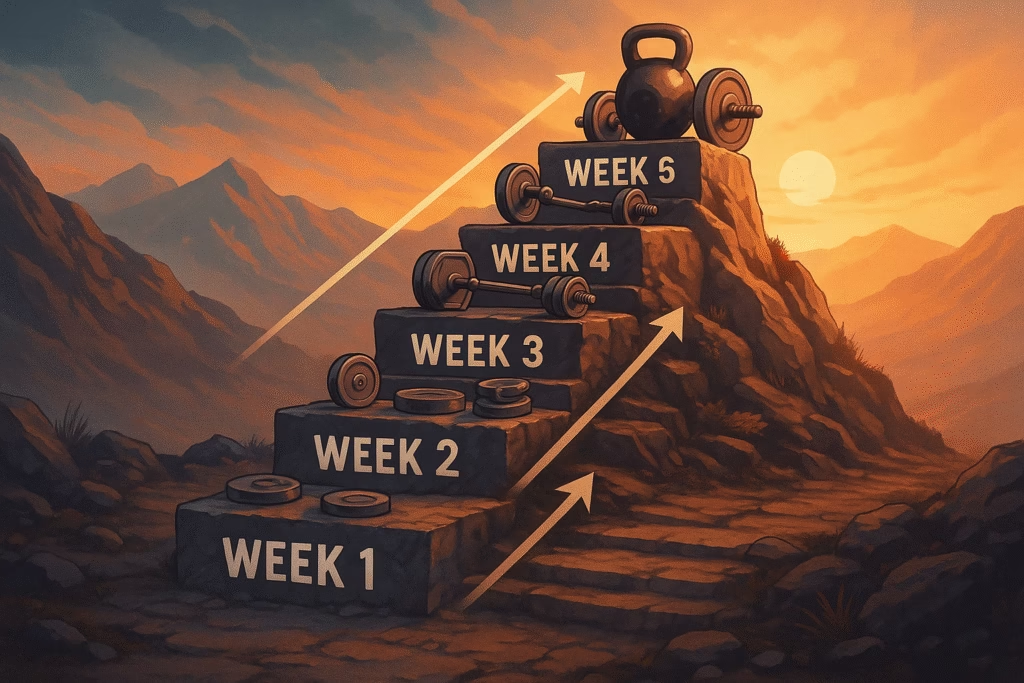
Week 1-2: Movement and Mobility
Goals: Pain-free movement, basic patterns Intensity: 40-50% of normal weights Volume: 50-60% of normal volume Focus: Perfect technique, no pain during or after
Sample workout:
- Trap bar deadlift from blocks: 3 sets of 8 at 135 lbs
- Goblet squats: 3 sets of 10 with 35 lb dumbbell
- Feet-up bench: 3 sets of 8 at 185 lbs
- Walking, gentle stretching daily
Week 3-4: Building Confidence
Goals: Increased load tolerance, movement quality Intensity: 60-70% of normal weights
Volume: 70-80% of normal volume Focus: Progressive overload within pain-free ranges
Sample progression:
- Lower blocks 2 inches on trap bar deadlifts
- Add 10-20 lbs to goblet squats or try box squats
- Return to regular bench if pain-free
- Add light accessory work
Week 5-6: Integration and Testing
Goals: Return to normal movement patterns Intensity: 70-85% of normal weights Volume: 80-90% of normal volume
Focus: Confidence building, technique refinement
Sample progression:
- Attempt floor-level deadlifts with light weight
- Try back squats to comfortable depth
- Test normal bench press setup
- Full accessory exercise menu
🎯 Pain Management Strategies That Actually Work
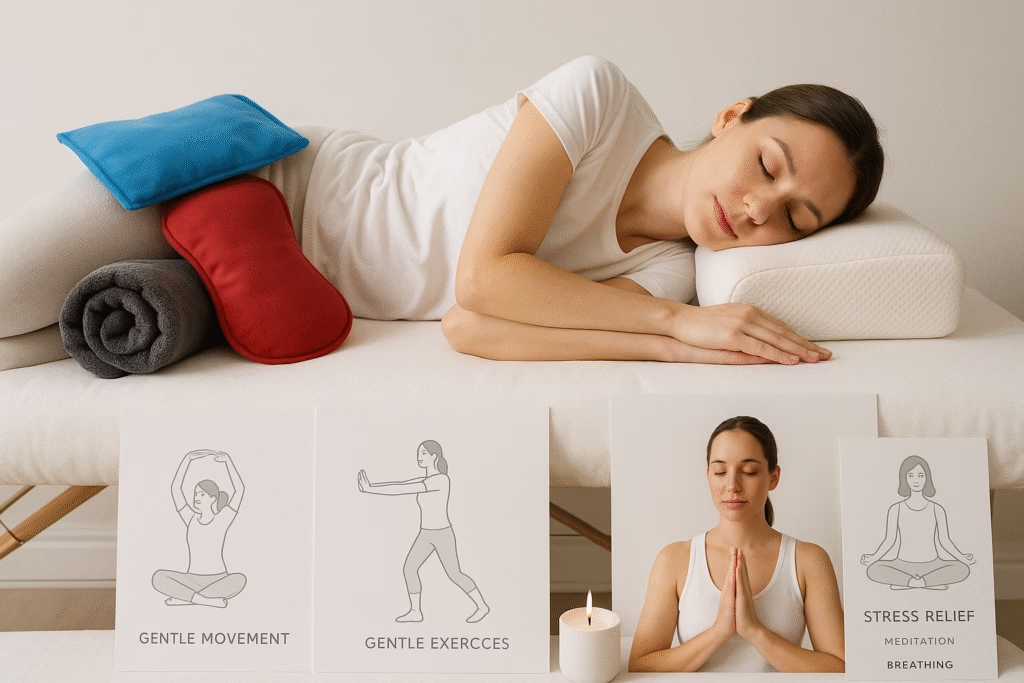
Heat vs. Ice: The Real Story
Ice (first 48-72 hours):
- Reduces inflammation and swelling
- 15-20 minutes every 2-3 hours
- Don’t ice right before training
Heat (after 72 hours):
- Improves blood flow and mobility
- 15-20 minutes before training
- Heating pad or warm shower works
Movement is Medicine
Why sitting makes it worse: Prolonged sitting increases disc pressure and tightens hip flexors The solution: Set a timer to move every 30-60 minutes, even during work
Gentle movements that help:
- Cat-cow stretches (10 reps every hour)
- Standing hip flexor stretches
- Walking for 5-10 minutes every few hours
- Gentle spinal rotations while standing
Sleep Position Matters
Best positions for back pain:
- On your side with pillow between knees
- On your back with pillow under knees
- Avoid stomach sleeping (increases back arch)
Stress and Pain Connection
Lower back pain often worsens with stress. High cortisol levels increase inflammation and muscle tension. Consider stress management techniques like deep breathing, meditation, or talking to a counselor.
🚩 Red Flags: When to Seek Immediate Help

Emergency Situations (Call 911):
- Loss of bowel or bladder control
- Severe weakness in both legs
- Numbness in groin/genital area
- Severe pain with fever
See a Doctor Within 24-48 Hours:
- Pain shooting down both legs
- Significant leg weakness
- Numbness or tingling in feet
- Pain that’s getting worse despite rest
- New onset severe pain after trauma
Schedule an Appointment This Week:
- Pain persisting more than a few days
- Recurring episodes of the same pain
- Pain interfering with sleep or daily activities
- You’re unsure about returning to training
🔍 Working with Healthcare Providers
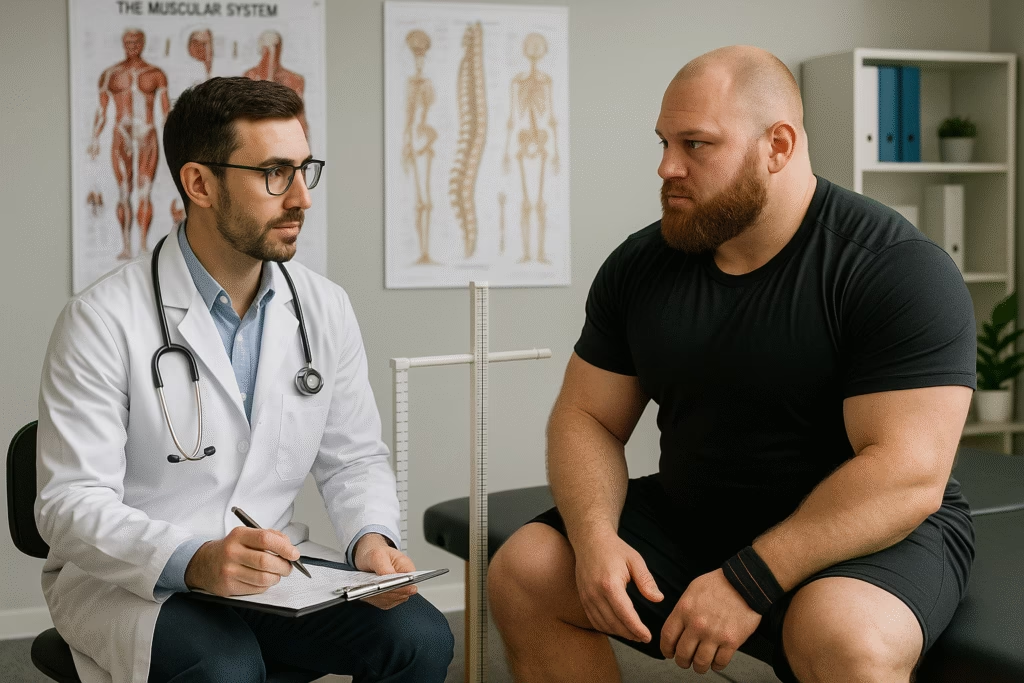
Finding the Right Professional
Sports medicine doctors: Best for diagnosis and clearance to return to sport Physical therapists: Excellent for movement assessment and exercise prescription
Chiropractors: Can help with joint mobility and movement patterns Massage therapists: Good for muscle tension and soft tissue work
Questions to Ask Your Provider:
- “Do you work with powerlifters or strength athletes?”
- “What movements should I avoid and for how long?”
- “What exercises can help me get back to deadlifting safely?”
- “How will we know when I’m ready for full training?”
What to Bring to Your Appointment:
- Videos of your lifting technique
- Training log showing when pain started
- List of movements that hurt vs. feel fine
- Specific goals (return to competition, general strength, etc.)
💡 Long-Term Prevention Strategies
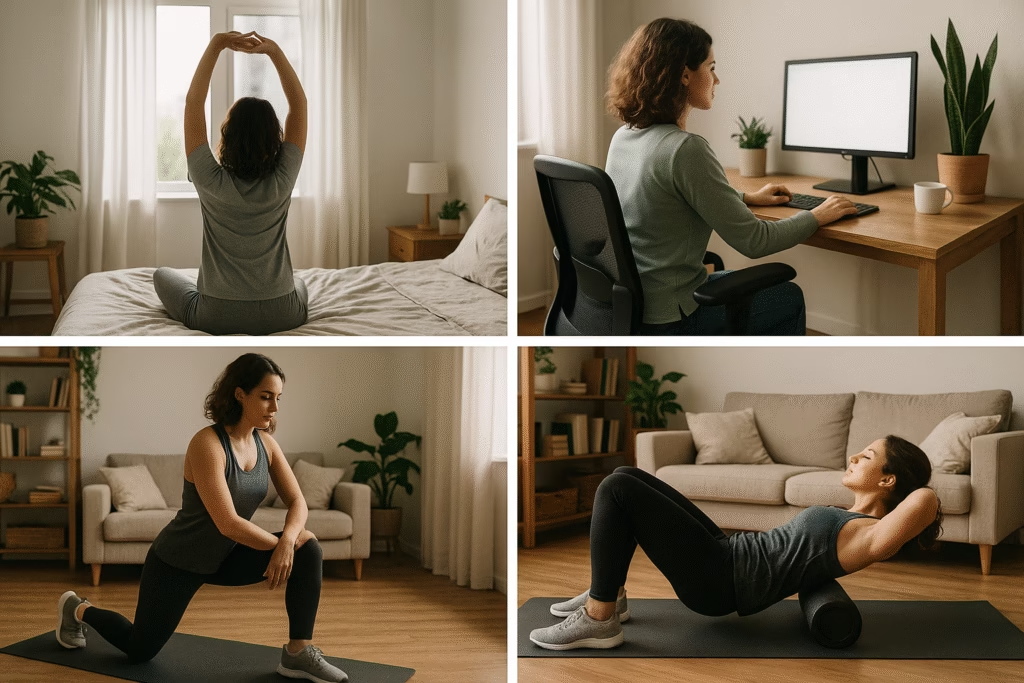
Daily Habits That Prevent Re-injury
Morning routine (5 minutes):
- Cat-cow stretches in bed
- Gentle spinal rotations
- Hip flexor stretch before standing
- Walk around before sitting for breakfast
Workday habits:
- Stand and move every hour
- Use a standing desk part of the day
- Stretch hip flexors during breaks
- Keep good posture awareness
Pre-training ritual:
- 10-15 minute dynamic warm-up
- Hip flexor and glute activation
- Gradually build to working weights
- Mental check-in with your back
Technique Refinements to Prevent Re-injury
Deadlift form focus:
- Master hip hinge with bodyweight first
- Keep bar close to body throughout lift
- Lead with chest, not hips
- Practice proper breathing and bracing
Squat adjustments:
- Work on ankle and hip mobility daily
- Strengthen glutes to prevent hip shift
- Find your optimal stance width
- Don’t force depth beyond your mobility
Lifestyle modifications:
- Prioritize 7-9 hours of sleep
- Manage stress through healthy outlets
- Stay hydrated (discs need water to function)
- Maintain healthy body weight
📊 Sample Training Week During Back Pain Recovery
Monday: Lower Body Focus
- Trap bar deadlift from blocks: 4 sets of 6
- Goblet squats: 3 sets of 12
- Walking lunges: 3 sets of 10 each leg
- Glute bridges: 3 sets of 15
- Planks: 3 sets of 30 seconds
Wednesday: Upper Body Emphasis
- Feet-up bench press: 4 sets of 8
- Incline dumbbell press: 3 sets of 10
- Seated rows: 4 sets of 12
- Lat pulldowns: 3 sets of 12
- Band pull-aparts: 100 total reps
Friday: Movement Quality
- Box squats to high box: 4 sets of 5
- Romanian deadlifts (light): 3 sets of 10
- Floor press: 3 sets of 8
- Face pulls: 3 sets of 15
- Dead bugs: 2 sets of 10 each side
Daily: Mobility and Recovery
- Morning: 5 minutes gentle movement
- Pre-training: 15 minutes dynamic warm-up
- Post-training: 10 minutes stretching
- Evening: Heat therapy if helpful
🎯 Mindset and Mental Strategies
Overcoming Fear of Re-injury
Start conservative: It’s better to progress slowly than to re-injure and start over Celebrate small wins: Pain-free squats to parallel are a victory Trust the process: Healing takes time, and setbacks are normal Focus on what you can do: Don’t obsess over what you can’t do yet
Setting Realistic Expectations
Timeline reality check:
- Acute pain: 3-7 days for significant improvement
- Return to modified training: 1-3 weeks
- Return to normal training: 4-8 weeks
- Full confidence and strength: 2-4 months
Progress isn’t always linear: You might have good days and bad days. This is normal and doesn’t mean you’re not healing.
Building Long-term Resilience
View this as education: Learning to train around injuries makes you a smarter, more durable lifter Develop multiple movement patterns: Having alternatives makes you less fragile Listen to your body: Pain is information, not something to always push through
🏆 Success Stories: Real Lifters, Real Results

Case Study 1: Sarah, 28, Herniated L5-S1
Initial injury: Severe pain radiating down right leg after deadlift PR attempt Timeline: 6 weeks modified training, 3 months to full training Key strategies: Started with walking and gentle stretches, progressed to trap bar deadlifts, eventually returned to conventional deadlifts stronger than before Outcome: Set new PRs in all three lifts 6 months post-injury
Case Study 2: Mike, 45, Chronic Lower Back Stiffness
Initial problem: Years of morning stiffness, occasional flare-ups during training Approach: Daily mobility routine, form refinements, stress management Key changes: Switched to sumo deadlifts, added hip flexor stretching, improved sleep habits Outcome: First pain-free year of training in a decade
Case Study 3: Jessica, 22, Acute Muscle Strain
Initial injury: Sharp pain during squat session, muscle spasm Recovery approach: 3 days complete rest, then goblet squats and bodyweight movements Progression: Box squats to front squats to back squats over 4 weeks Lesson learned: Sometimes the simple approach works best
🔬 The Science Behind Training with Back Pain
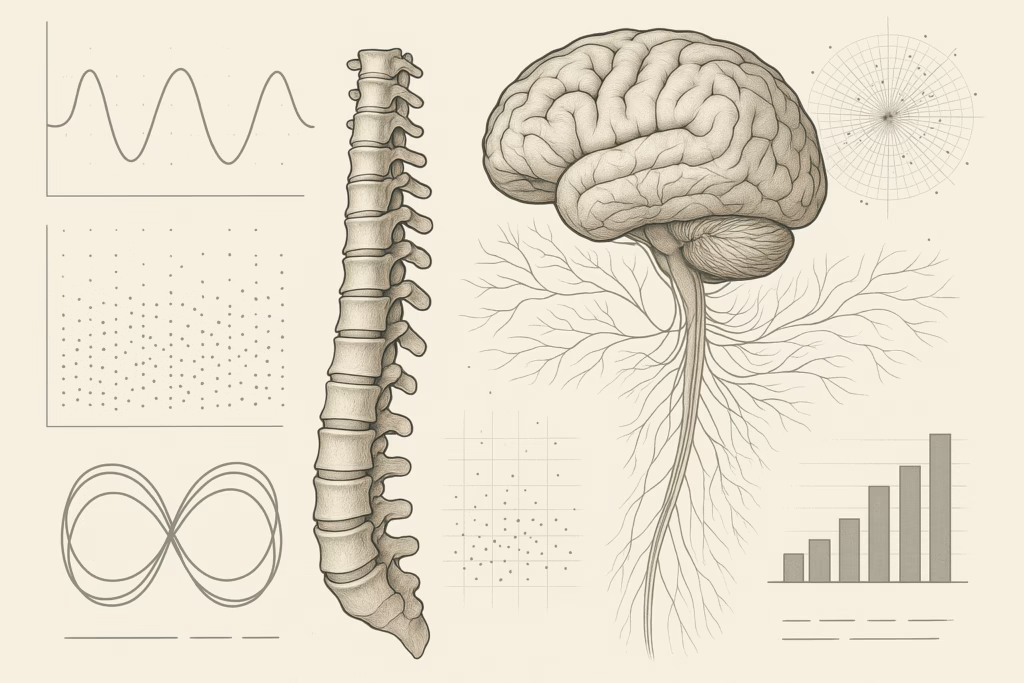
Why Movement Helps More Than Rest
Research shows: Prolonged bed rest can actually delay recovery and increase re-injury risk The mechanism: Movement promotes blood flow, prevents stiffness, and maintains strength The sweet spot: Stay active within pain-free ranges while avoiding aggravating movements
Pain Science Basics
Pain doesn’t always equal damage: Your nervous system can be overly protective Context matters: The same movement might hurt in the gym but feel fine during daily life Fear amplifies pain: Catastrophic thinking can make pain worse and last longer
Neuroplasticity and Recovery
Your brain adapts: Movement patterns associated with pain can become “learned” even after tissues heal The solution: Gradually reintroduce movements with positive experiences Success breeds success: Each pain-free training session rewires your nervous system
📝 Tracking Your Recovery Progress
Daily Pain and Function Scale
Rate your pain (0-10):
- 0: No pain
- 1-3: Mild discomfort, doesn’t limit activity
- 4-6: Moderate pain, limits some activities
- 7-8: Severe pain, limits most activities
- 9-10: Excruciating pain, can’t function
Track function:
- Can you sit for 30 minutes comfortably?
- Can you bend forward to touch your toes?
- Can you walk up stairs without pain?
- Can you sleep through the night?
Training Load Monitoring
Week by week tracking:
- Total volume lifted
- Average intensity (% of pre-injury max)
- Pain levels during and after training
- Movement quality self-assessment
Objective Markers of Progress
Range of motion improvements:
- Toe touch distance from floor
- Hip flexor stretch comfort
- Squat depth without pain
Strength benchmarks:
- Goblet squat weight progression
- Trap bar deadlift from blocks
- Pain-free movement thresholds
🎯 Your Next Steps: The Action Plan
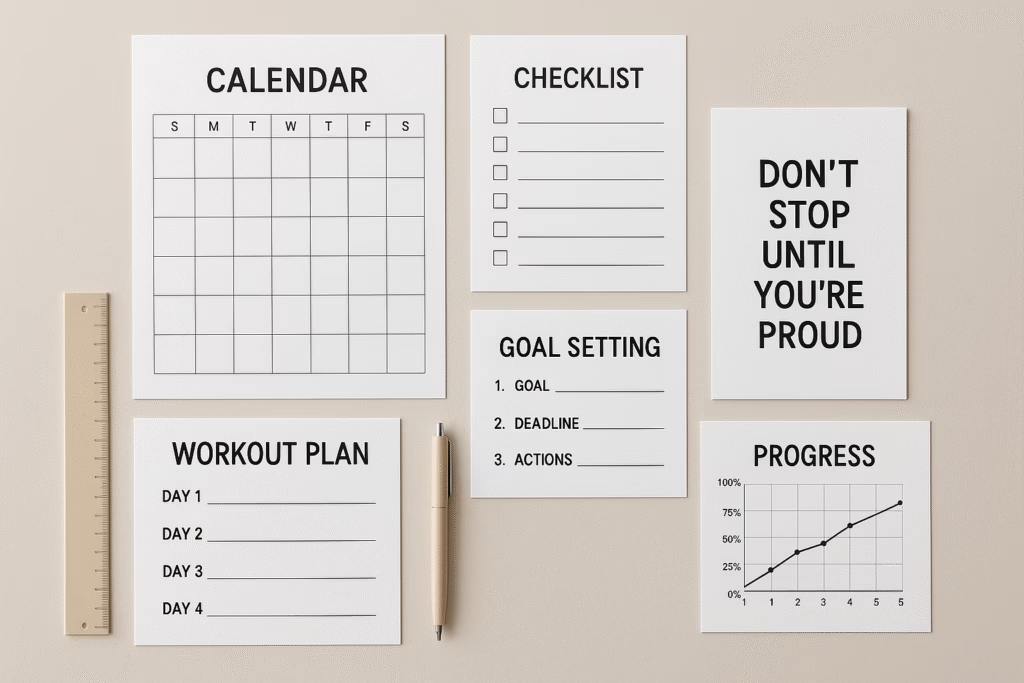
This Week:
- Assess your current pain level – Use the 0-10 scale
- Identify pain-free movements – Test basic patterns with bodyweight
- Start daily mobility routine – 10 minutes of gentle movement
- Consider professional help – If pain persists or worsens
This Month:
- Implement modified training program – Focus on pain-free ranges
- Track your progress daily – Pain levels, function, sleep quality
- Address lifestyle factors – Sleep, stress, sitting habits
- Build confidence gradually – Celebrate small victories
Next 3 Months:
- Progressive return to normal training – Follow systematic progression
- Develop injury prevention habits – Daily mobility, proper warm-up
- Learn from the experience – What caused it? How can you prevent it?
- Consider working with professionals – Coach, physical therapist, or sports medicine doctor
🏆 The Bottom Line: Patience Pays Off
Lower back pain doesn’t have to end your powerlifting career. With smart modifications, gradual progression, and attention to movement quality, most lifters can return to full training stronger and more resilient than before.
Remember the key principles:
- Pain is information, not always damage
- Movement is medicine when done correctly
- Progress isn’t always linear
- Prevention is easier than rehabilitation
- Professional help speeds recovery
The strongest lifters aren’t those who never get injured – they’re the ones who learn to train smart, listen to their bodies, and come back from setbacks with greater wisdom and resilience.
Your back pain might be frustrating now, but it can become your greatest teacher in the gym.
Ready to train smart around your back pain? Start with one modification today and build your way back to the platform.
FAQs
Q: Can I still compete with lower back pain?
A: This depends on your pain level and type. Mild, familiar pain that doesn’t worsen with training might be manageable for competition, but sharp or severe pain should not be competed through. Always consult with a sports medicine professional before competing with any injury.
Q: Which deadlift variation is best when my back hurts?
A: Trap bar deadlifts from blocks are usually the best starting point, as they reduce spine flexion and allow a higher starting position. Sumo deadlifts are often more comfortable than conventional due to the more upright torso position. Romanian deadlifts can maintain the hip hinge pattern without floor pickup.
Q: Should I completely avoid squats if my back hurts?
A: Not necessarily. Goblet squats and box squats to a high box are often pain-free alternatives that maintain the movement pattern. Front squats promote better posture and may be more comfortable than back squats. The key is finding a pain-free range of motion.
Q: Can bench press make my back pain worse?
A: Yes, if you’re using excessive arch or have tight hip flexors. Try feet-up bench press to maintain neutral spine, incline bench for a more upright position, or floor press to limit range of motion while still allowing heavy pressing work.
Q: Is it safe to do cardio with lower back pain?
A: Walking is usually safe and beneficial for back pain. Avoid high-impact activities like running or jumping until pain subsides. Swimming can be excellent if available, as water supports body weight and reduces spinal loading.
